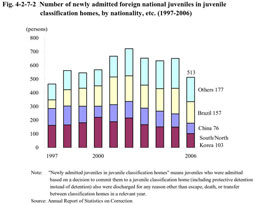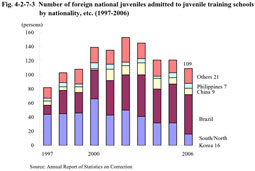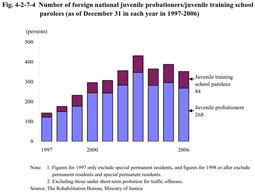| Previous Next Index Image Index Year Selection | |
|
|
2 Treatment of foreign national juvenile delinquents
(1) Juvenile classification homes
Fig. 4-2-7-2 shows the number of newly admitted foreign national juveniles in juvenile classification homes over the last 10 years, by nationality, etc. Among newly admitted foreign national juveniles in 1997, the rate of South/North Koreans was the highest with 35.1%, but that of Brazilians was the highest with 30.6% in 2006. Fig. 4-2-7-2 Number of newly admitted foreign national juveniles in juvenile classification homes, by nationality, etc. (1997-2006) (2) Juvenile training schools Fig. 4-2-7-3 shows the number of foreign national juveniles newly admitted to juvenile training schools by nationality, etc. over the last 10 years. In 1997, 53.7% of the total foreign national juveniles newly admitted to juvenile training schools were South/North Koreans, but in 2006, Brazilians had the largest share with 51.4%. Fig. 4-2-7-3 Number of foreign national juveniles admitted to juvenile training schools by nationality, etc. (1997-2006) Among the treatment courses at juvenile training schools (see Chapter 2, Section 4, 2(2)c), the living guidance course G2 was established in 1993 so as to cope with an increase in foreign national juveniles admitted to juvenile training schools. In this course, treatment is provided for foreign national juveniles who need treatment different from that for Japanese juveniles, placing focus on guidance on basic living habits, Japanese-language acquisition, and future life plans from early stages according to their places to return after discharge.(3) Probation/parole supervision In 2006, the number of foreign national juveniles newly placed under probation/parole supervision (excluding juveniles under short-term probation due to traffic offenses; hereinafter the same in this subsection) was 511 juveniles (down by 7.4% from the previous year). By nationality, etc., the number of foreign national juvenile probationers/juvenile training school parolees was largest for Brazilian (187 juveniles in total), followed by South/North Korean (149 juveniles (id.)), Chinese (64 juveniles (id.) including Taiwanese), Filipino (35 juveniles (id.)), and Peruvian (21 juveniles (id.)). Fig. 4-2-7-4 shows the trends in the number of foreign national juvenile probationers/juvenile training school parolees (excluding permanent residents and special permanent residents; hereinafter the same in this section) as of December 31 in each year, over the last 10 years. Fig. 4-2-7-4 Number of foreign national juvenile probationers/juvenile training school parolees (as of December 31 in each year in 1997-2006) At the Ministry of Justice, introductory pamphlets on probation/parole supervision are provided (in 13 languages) as an effort to facilitate the process of introducing the probation/parole supervision system to probationers, juvenile training school parolees, and guardians of foreign nationals who have limited understanding of Japanese. Further, efforts are made to enhance treatment of juvenile probationers and juvenile training school parolees of foreign nationals such as providing necessary documents in foreign languages, arranging for translators, and coordinating with related agencies. |


